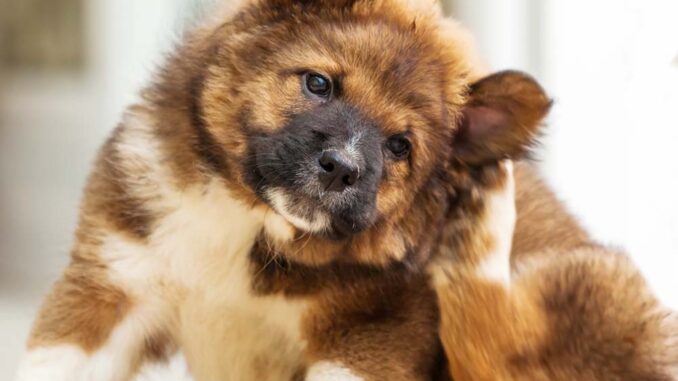
This article was updated on June 13th, 2023

Ear infections are very commonly seen in dogs. In our veterinary practice, I see about 5 dogs each day with ear infections. Many times, they can be due to allergies, or hair and dirt getting trapped in your dog’s ears. Keeping your dogs’ ears clear of debris, and monitoring your dog for signs of allergies can help prevent these issues.
How Do I Know if My Dog Has an Ear Infection?
The most common signs are when dogs shake their heads or scratch their ears. It is usually very easy to know if your dog has an ear infection. First, look in their ears to see if there is debris or discharge:
- Black to brown dog ear wax debris is usually a sign of yeast infection in your dog’s ears.
- A very light tan to yellowish goopy discharge coming from your dog’s ears is a sign of a bacterial infection.
- Many times your dog has both a yeast and a bacterial infection.
Another way to know if your dog has an ear infection is by smelling their ears. If their ears smell very bad, they most likely have an infection.
If your dog shakes their head but their ears are clean, you can read our article from Dr. Ellen Russell: “Dog Shaking Head But Ears are Clean?”
Other symptoms of ear infections in dogs include:
- Redness inside the ear
- Red spots or pimples on your dog’s ear
- Crust or scabs inside the ear
- Whining
5 Most Frequent Types of Dog Ear Infections (With Images)
There are many different reasons that your dog may have an ear infection. These are some common types:
1. Dermatitis Ear Infections
Dermatitis is an inflammation and infection in your dog’s skin. The main sign of dermatitis in dogs is red, inflamed, and itchy skin.
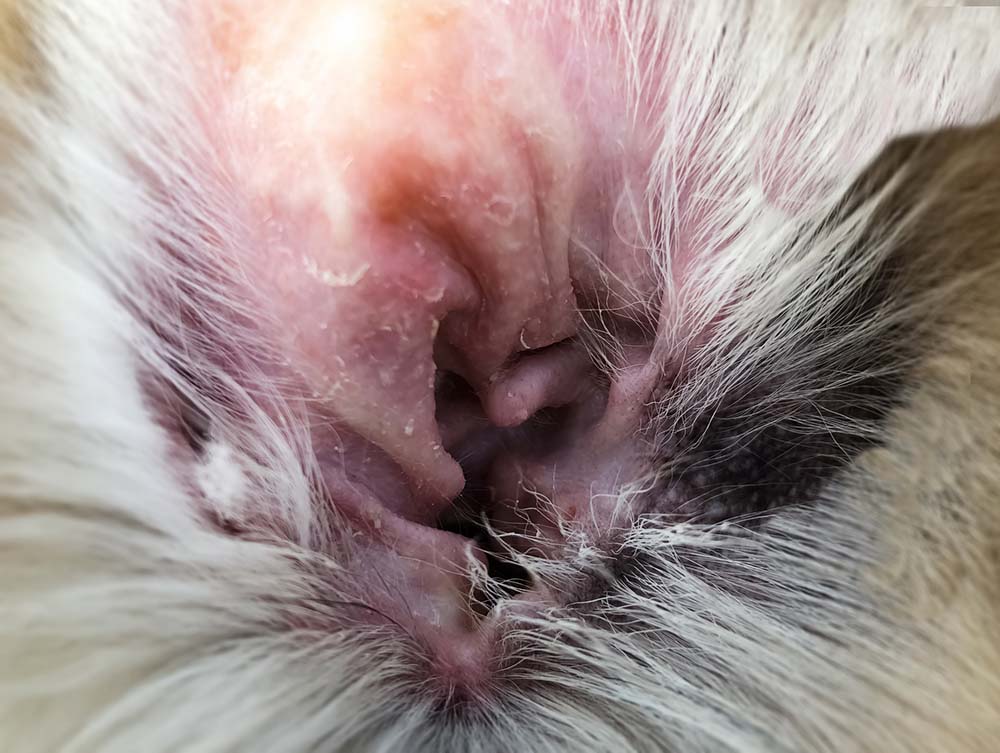
Dogs with dermatitis will benefit from an ear cleaner and solution. Speak to your veterinarian for advice.
2. Ear Infections Due to An Allergy
Allergies are very commonly seen in early spring to late fall. When new plants are blooming, and pollen is in the air, many dogs will show signs of seasonal allergies. A typical presentation for allergies in dogs is an ear infection. Most dogs who have allergies will have very red and itchy ears. They may not have any waxy debris in their ears but will constantly be scratching their ears.
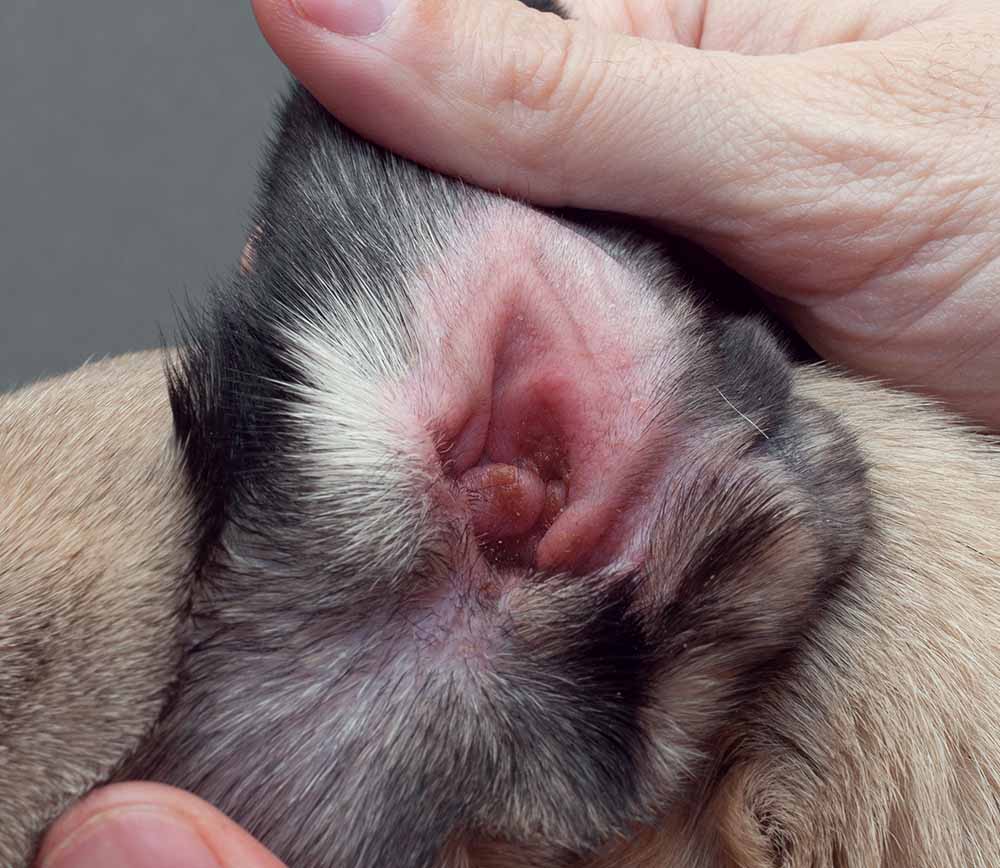
Seasonal allergies can also cause skin issues including skin inflammation in the form of itchiness, redness, and heat. Excessive rubbing and irritation can lead to hair loss and the breakdown of the skin barrier which allows bacteria to overpopulate and cause secondary infections.
These dogs need to see a veterinarian for diagnosis as well as treatment of the ear infection and allergies. Learn more about ear infections due to allergies.
3. Ear Mite Infections
Dogs with ear mites are very rare, as this is mostly a cat issue. However, in some cases, ear mites may affect a dog and will require veterinary prescription treatment. OTC ear mites remedies are typically ineffective.
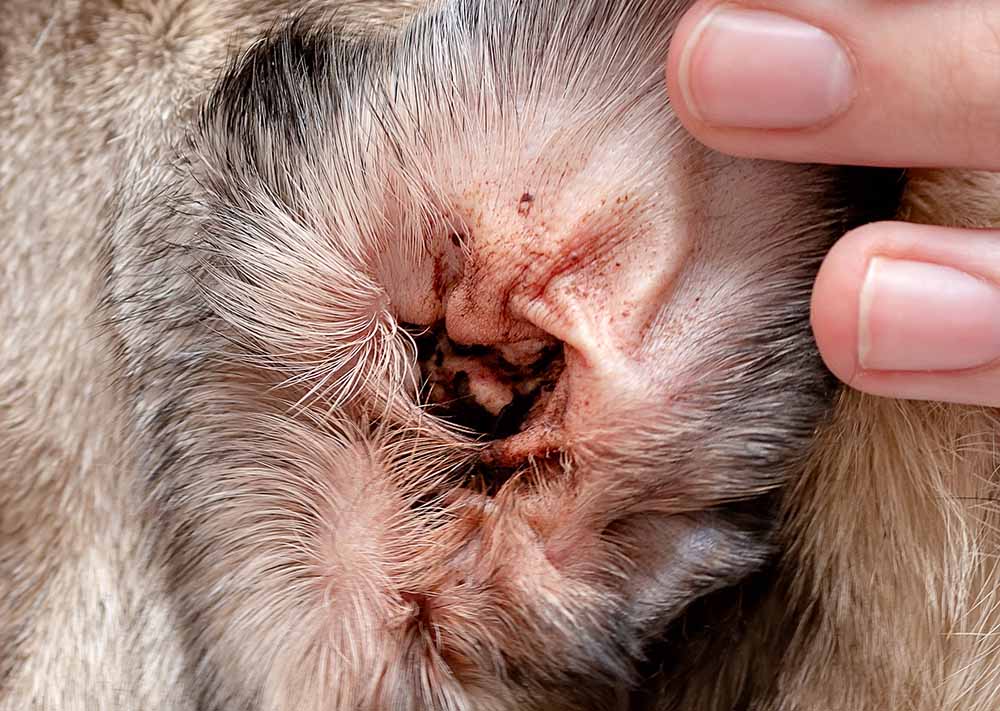
4. Ear Infections from Fleas or Ticks
In dogs who have ear infections secondary to fleas and ticks, you can visually see fleas and ticks near your dog’s ears. Your dog may also be itching their ears too.
Fleas and ticks pose a threat of severe disease not only to your dog, but also to you and your family. You should contact your veterinarian as soon as possible for effective treatment and prevention.
5. Dog Yeast Ear Infections
Yeast ear infections can lead your dog to exhibit the following signs: red, yellow, or brown wax discharge, itching, scratching, head tilt, loss of balance, a cheesy smell, or a red or irritated ear (note that bacterial ear infections can also show similar symptoms, so it’s important to get your vet’s assessment to determine the right diagnosis and treatment). Check out these yeast ear infection pictures.

For dogs with a yeast infection in their ears, after a proper diagnosis from their veterinarian, treatment will consist of cleaning and flushing the ears and an appropriate prescription ear medication.
What Can I Do to Help Prevent Ear Infections at Home?
At home, there are many different things that you can try to help with prevention:
1. Clean your dog’s ears

The best thing that you can do is to clean your dog’s ears once a week. You can find many different ear cleaners at your local pet store, online, or even at your vet’s office to clean your dog’s ears.
My favorite products include the following:
Other great ear medications that you can find at your local pet store or online are:
** Always consult with your veterinarian before giving your dog any medication **
You can also read our guide to dog ear cleaning with more product recommendations.
How to Clean your Dog’s Ears:
When you clean your dog’s ears make sure you have ear cleaner, someone to help, and some cotton balls.
- Fill the ear canal with ear cleaner.
- Place a few cotton balls over the opening of the ear
- Gently massage the base of your dog’s ear
- Remove the cotton balls and use clean cotton balls to wipe away any excessive debris.
- Continue this process until you no longer have dirty cotton balls.
- If your dog’s ears start to bleed – stop cleaning and make an appointment with their vet.
Other tips for cleaning your dog’s ears:
- Use Ear Wipes: Ear wipes are great at helping keep your dog’s ears clean. This is something that you can use every day to just wipe out any dirt or debris from your dog’s ears.
- Keep Hair Short: When you take your dog to the groomer, try to keep your dog’s hair free of extra hair and keep the hair around the ear short. This will help keep their ears dry and free of any infection.
2. Remove any excessive hair from ears
If you have a breed of dog that is known for having a lot of hair growing in and around their ears, remove this hair from their ears. You can learn to do this at home, or many groomers can do this for you when your dog is getting groomed. Learn more: Removing Ear Hair.
Can a Dog’s Ear Infection Go Away on its Own?
If you caught it very early and start cleaning your dog’s ear at home, the infection may go away without veterinary care. If you do not do anything about it, it will get worse – most of the time – and could become quite miserable for your dog. In any case, the problem is NOT likely to just go away, and we recommend always seeking the help of your veterinarian.
The Importance of Veterinary Treatment
We recommend consulting with your veterinarian if you suspect that your dog has an ear infection. This is because an ear infection can get worse over time, expand inside your dog’s ear canal and make life very uncomfortable for your canine friend. The resultant inflammation leads to scar tissue which makes your dog more prone to infections in the future, makes treatment more challenging, and can affect their hearing.
Early treatments will yield the best results and help ensure your dog remains comfortable. While you wait for your veterinary appointment, there are a number of steps you can take at home to help your dog.
When to See a Vet

If you have tried cleaning your dog’s ears at home with no improvement for a day, it is best to see your vet as soon as possible. If your dog’s ears have pus-like material coming from them, these will most likely need a prescription ear medication to help, so you should not delay veterinary treatment.
When you take your dog to the vet with an ear infection, your vet will thoroughly clean your dog’s ear and prescribe them antibiotic or antifungal medication to go into their ears, as described in the next section.
Veterinary treatments
Many vets will clean your dog’s ears at the veterinary clinic and apply medication to your dog’s ears that lasts a week or two. Some of these treatments need to be repeated, and others will clear the infection after only one treatment. If your dog has a really bad ear infection, your vet may even send you home medication to put into your dog’s ear each day.
Depending on the type of infection, veterinary treatments may include:
- antibiotics
- antifungal medications
- anti-inflammatory medications
- topical medications
What are the Results and the Costs?
The cost of treatment can differ depending on where you live and how bad your dog’s ears are. Typical costs can be $200 to $700. Your vet can give you an estimate with a breakdown of the cost of treatment before they start treating your dog’s ears.
How Long is the Treatment?
Most simple dog ear infections typically heal in a few days, sometimes up to two weeks.
Prevention tips
If your dog keeps having ear infections, it would be best to try to clean their ears at least once a week. By cleaning their ear frequently, you will help prevent any buildup of infection and possibly even prevent future issues.
Sometimes dogs have ear infections due to allergies. It is essential to treat the underlying allergies in order to prevent these types of ear infections.
Are Certain Breeds Prone to Ear Infections?
Yes, there are certain breeds that are more prone to develop ear infections than others. These breeds are:
1) Breeds with Excess Hair in the Ear Canals: Dogs such as poodles or shi tzus who have hair that grows in the ear canal will have more ear infections than dogs that do not have hair in their ears. The hair in these dogs’ ears will trap moisture and debris making it a perfectly dark environment for bacterial and yeast growth.
2) Dog Breeds Prone to Allergies: Dogs who have seasonal allergy issues or food allergies will have chronic ear infections. Giving your dog allergy medication or switching their diet to an allergy diet will help decrease these issues.
3) Small Ear Canals: dogs with very narrow ear canals will be more prone to ear infections. These canals do not have a large enough opening for light and air to get into your dog’s ear to help keep them free of infections.
4) Long, Floppy Ears: Dogs with long and floppy ears will be very prone to infections. These ears will create a very dark environment in your dog’s ear which bacteria and fungus love to grow in.
Related post: Golden Retrievers and Ear Infections.
Are ear infections contagious to other dogs or humans?
No, they do not generally spread from dog to dog or from dog to human. The most common causes of ear infections in dogs include overgrowth of bacteria or yeast – which are usually specific to the dog’s ear and do not spread easily to other dogs or humans (with a few exceptions). Learn more: Are Dog Ear Infections Contagious?
Read More About Dog Ears:
 Dog Ear Flap Issues: Cysts, Lumps & Bumps [With Pictures] - As a veterinarian, I often come across various ear flap conditions, which can be quite concerning for pet owners. However,… [...]
Dog Ear Flap Issues: Cysts, Lumps & Bumps [With Pictures] - As a veterinarian, I often come across various ear flap conditions, which can be quite concerning for pet owners. However,… [...] 6 Top Causes of Red Rash or Red Spots in Dog’s Ear - Most of us have a special affection for our dog’s ears. They’re velvety soft and either short and perky or… [...]
6 Top Causes of Red Rash or Red Spots in Dog’s Ear - Most of us have a special affection for our dog’s ears. They’re velvety soft and either short and perky or… [...] Home Remedies for Dog Ear Infections [Vet Approved] - If your dog is scratching their ears or shaking their head, they may be bothered by an ear infection. Skin… [...]
Home Remedies for Dog Ear Infections [Vet Approved] - If your dog is scratching their ears or shaking their head, they may be bothered by an ear infection. Skin… [...]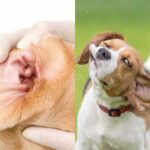 Dog Shaking Head But Ears are Clean? Our Vet Explains Top Causes - It’s common for dogs to normally shake their heads and flap their ears, especially after swimming, baths, when they’re excited,… [...]
Dog Shaking Head But Ears are Clean? Our Vet Explains Top Causes - It’s common for dogs to normally shake their heads and flap their ears, especially after swimming, baths, when they’re excited,… [...] Dog Has Scabs On Ears: Top Causes & Vet Advice - In this article, our experienced veterinarian Dr. Chyrle Bonk walks you through common causes of scabs on a dog’s ears,… [...]
Dog Has Scabs On Ears: Top Causes & Vet Advice - In this article, our experienced veterinarian Dr. Chyrle Bonk walks you through common causes of scabs on a dog’s ears,… [...] Yeast Ear Infections in Dogs – With Pictures & Vet Advice - Yeast ear infections are a common health condition in our canine companions, often causing: intense ear scratching, black or brown… [...]
Yeast Ear Infections in Dogs – With Pictures & Vet Advice - Yeast ear infections are a common health condition in our canine companions, often causing: intense ear scratching, black or brown… [...] Dog Ear Yeast Infection or Ear Mites? Our Veterinarians Explain - As pet owners, we want our dogs to be healthy from head to toe. But one area that often gets… [...]
Dog Ear Yeast Infection or Ear Mites? Our Veterinarians Explain - As pet owners, we want our dogs to be healthy from head to toe. But one area that often gets… [...]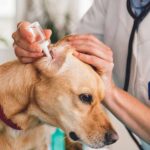 9 Best Dog Ear Cleaning Solutions, According to a Vet - Not every dog is going to require regular ear cleaning. In fact, overcleaning healthy ears can upset the normal balance… [...]
9 Best Dog Ear Cleaning Solutions, According to a Vet - Not every dog is going to require regular ear cleaning. In fact, overcleaning healthy ears can upset the normal balance… [...] Dog Ear Wax Color Chart: When Color Can Indicate a Problem - A dog’s ears present a lot of questions for their owners, many of which revolve around ear wax. There are… [...]
Dog Ear Wax Color Chart: When Color Can Indicate a Problem - A dog’s ears present a lot of questions for their owners, many of which revolve around ear wax. There are… [...]Disclaimer: This website's content is not a substitute for veterinary care. Always consult with your veterinarian for healthcare decisions. Read More.










Be the first to comment